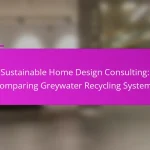Sustainable home design integrates building codes that prioritize safety, energy efficiency, and environmental responsibility, guiding builders and homeowners toward eco-friendly practices. By employing innovative construction methods, these designs significantly reduce resource consumption and waste, fostering a healthier living environment. Ultimately, embracing sustainability not only benefits the planet but also enhances the quality of life for residents through long-term savings and improved energy efficiency.

What are the key building codes for sustainable home design in the US?
The key building codes for sustainable home design in the US include regulations that ensure safety, energy efficiency, and environmental responsibility. These codes guide builders and homeowners in creating structures that minimize environmental impact while adhering to safety standards.
International Building Code (IBC)
The International Building Code (IBC) sets forth minimum requirements for building safety and sustainability. It covers aspects such as structural integrity, fire safety, and accessibility, which are crucial for sustainable home design. Compliance with the IBC is mandatory in most jurisdictions across the US.
When designing a sustainable home, it’s essential to understand how the IBC applies to your specific project. For instance, using sustainable materials may require adjustments to structural calculations to meet IBC standards.
Energy Code Compliance
Energy code compliance focuses on reducing energy consumption and enhancing efficiency in buildings. The most commonly referenced codes include the International Energy Conservation Code (IECC) and local adaptations that may impose stricter requirements.
To comply, consider implementing energy-efficient systems such as high-performance insulation, energy-efficient windows, and renewable energy sources like solar panels. Regularly reviewing local energy codes can help ensure your design meets or exceeds these standards.
Local Zoning Regulations
Local zoning regulations dictate land use and building specifications, impacting sustainable home design. These regulations can include restrictions on building height, density, and the types of materials used, which can affect the overall sustainability of a project.
Before starting construction, check with local zoning boards to understand any limitations or requirements that may apply. This can help avoid costly redesigns or delays later in the process.
Green Building Standards
Green building standards, such as LEED (Leadership in Energy and Environmental Design) and the National Green Building Standard (NGBS), provide frameworks for sustainable construction practices. These standards promote energy efficiency, water conservation, and sustainable material use.
Obtaining certification under these standards can enhance the marketability of your home and may qualify you for financial incentives. Familiarize yourself with the criteria and consider integrating them into your design from the outset to streamline the certification process.
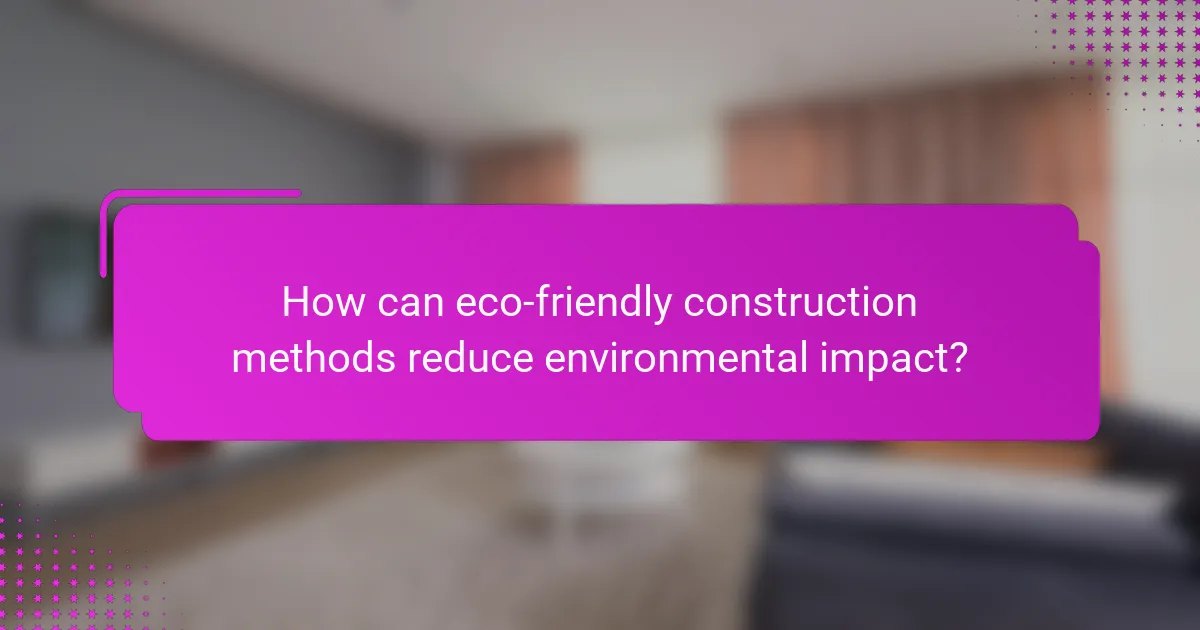
How can eco-friendly construction methods reduce environmental impact?
Eco-friendly construction methods significantly lower environmental impact by minimizing resource consumption, reducing waste, and enhancing energy efficiency. These practices not only protect natural ecosystems but also promote sustainable living through innovative design and material use.
Use of Recycled Materials
Utilizing recycled materials in construction helps divert waste from landfills and reduces the demand for new resources. Commonly recycled materials include reclaimed wood, recycled metal, and repurposed concrete, which can be incorporated into various building elements.
When selecting recycled materials, consider their source and quality to ensure structural integrity. It’s beneficial to check local regulations regarding the use of recycled content, as some areas may offer incentives or guidelines for sustainable practices.
Passive Solar Design
Passive solar design harnesses natural sunlight for heating and cooling, reducing reliance on artificial energy sources. Key strategies include orienting buildings to maximize sun exposure, using thermal mass materials, and incorporating large windows for natural light.
To effectively implement passive solar design, assess your site’s climate and orientation. Simple adjustments, like overhangs or shading devices, can significantly improve energy efficiency and comfort throughout the year.
Green Roofs and Walls
Green roofs and walls incorporate vegetation into building structures, providing insulation, reducing heat island effects, and improving air quality. These systems can also manage stormwater runoff, promoting biodiversity in urban areas.
When considering green roofs or walls, evaluate the structural capacity of your building and local climate conditions. Choose native plant species that require less maintenance and water, ensuring a sustainable and resilient green space.
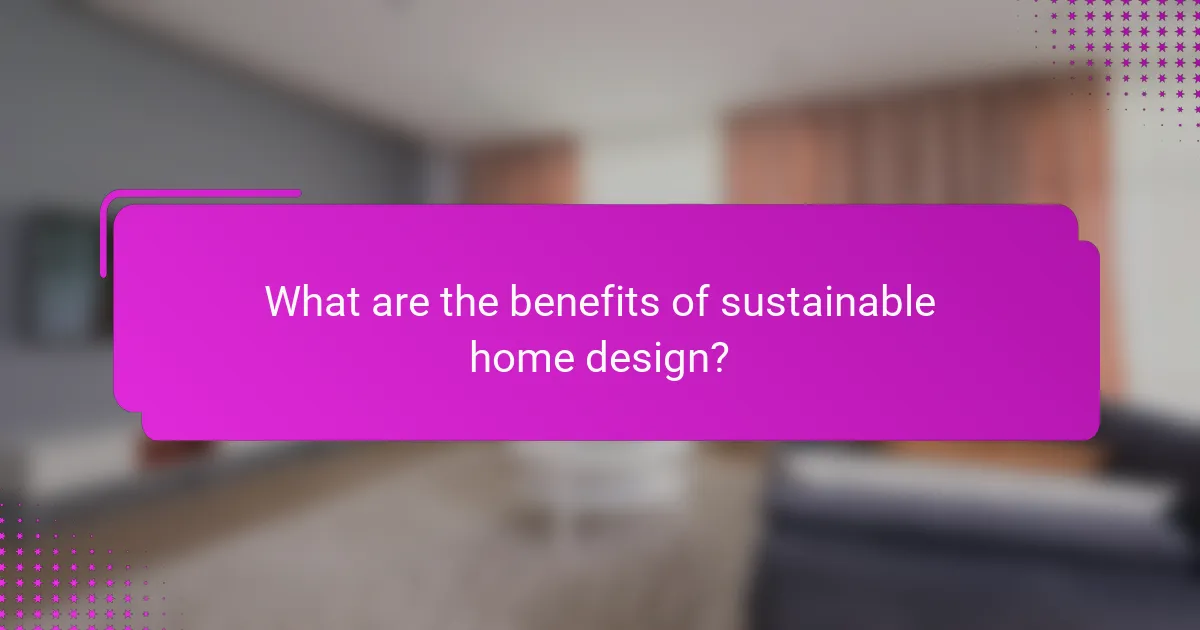
What are the benefits of sustainable home design?
Sustainable home design offers numerous advantages, including reduced environmental impact, improved energy efficiency, and enhanced quality of life. By incorporating eco-friendly practices, homeowners can enjoy long-term savings and a healthier living environment.
Energy Efficiency
Energy efficiency is a key benefit of sustainable home design, as it reduces energy consumption and minimizes waste. Homes designed with energy-efficient materials and technologies, such as high-performance insulation and energy-efficient windows, can significantly lower heating and cooling demands.
Consider implementing renewable energy sources, such as solar panels, which can further enhance energy efficiency. These systems can provide clean energy and reduce reliance on fossil fuels, contributing to a more sustainable future.
Lower Utility Costs
One of the most immediate benefits of sustainable home design is lower utility costs. By utilizing energy-efficient appliances and systems, homeowners can see reductions in their monthly energy bills, often by 20-50% depending on the improvements made.
Additionally, water-saving fixtures and landscaping can reduce water bills. Investing in sustainable practices not only benefits the environment but also leads to substantial financial savings over time.
Increased Property Value
Sustainable home design can lead to increased property value, as more buyers are seeking eco-friendly features. Homes that incorporate green building practices often appraise higher due to their energy efficiency and lower operating costs.
Moreover, properties with sustainable certifications, such as LEED or Energy Star, can attract environmentally conscious buyers willing to pay a premium for these features. This trend is becoming more pronounced in many markets, making sustainable homes a smart investment.
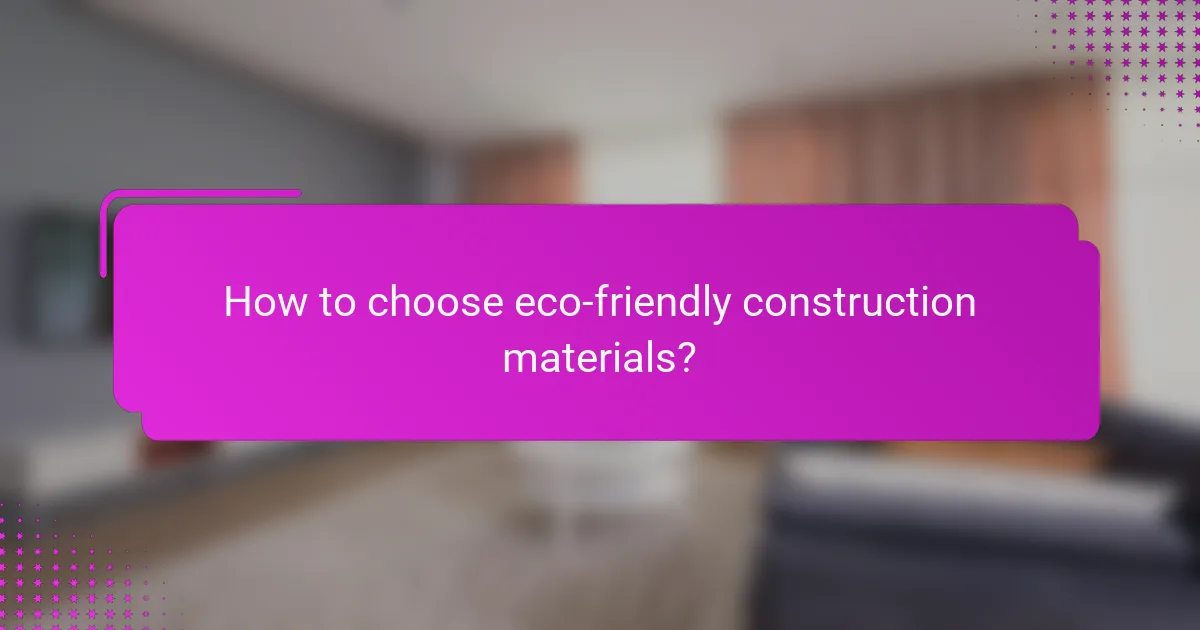
How to choose eco-friendly construction materials?
Choosing eco-friendly construction materials involves selecting products that minimize environmental impact while ensuring safety and durability. Focus on materials that are sustainably sourced, non-toxic, and energy-efficient to create a healthier living space.
Certified Sustainable Products
Certified sustainable products meet specific environmental standards, ensuring they are responsibly sourced and manufactured. Look for certifications such as FSC (Forest Stewardship Council) for wood, LEED (Leadership in Energy and Environmental Design) for building materials, and Energy Star for appliances.
Using certified products not only supports eco-friendly practices but can also enhance the value of your home. Always verify the certification claims through reputable organizations to ensure authenticity.
Locally Sourced Materials
Locally sourced materials reduce transportation emissions and support the local economy. When selecting materials, aim for those produced within a reasonable distance from your construction site, ideally within 500 miles.
Examples include local stone, timber, and clay. These materials often have lower carbon footprints and can add a unique regional character to your home.
Low-VOC Paints and Finishes
Low-VOC (volatile organic compounds) paints and finishes are essential for maintaining indoor air quality. These products emit fewer harmful chemicals, making them safer for occupants and the environment.
When choosing paints, look for options labeled as low-VOC or zero-VOC. They are widely available and come in various colors and finishes, allowing you to achieve your desired aesthetic without compromising health.

What are the compliance requirements for sustainable homes?
Compliance requirements for sustainable homes typically involve adherence to various building codes, certifications, and local regulations aimed at promoting eco-friendly construction practices. These requirements ensure that homes are energy-efficient, environmentally responsible, and safe for occupants.
LEED Certification Process
The LEED (Leadership in Energy and Environmental Design) certification process evaluates a building’s sustainability across several categories, including energy use, water efficiency, and materials selection. To achieve LEED certification, builders must meet specific prerequisites and earn points through various sustainable practices.
Key steps in the LEED certification process include registering the project, conducting a thorough assessment of sustainable features, and submitting documentation for review. Depending on the points earned, a project can achieve different levels of certification: Certified, Silver, Gold, or Platinum.
Energy Star Compliance
Energy Star compliance indicates that a home meets strict energy efficiency guidelines set by the U.S. Environmental Protection Agency (EPA). Homes that earn the Energy Star label are designed to use less energy, which translates to lower utility bills and reduced greenhouse gas emissions.
To qualify for Energy Star certification, homes must undergo testing for energy performance, including inspections of insulation, heating and cooling systems, and appliances. Builders should aim for a home that scores at least 75 on the Energy Star rating scale, which reflects superior energy efficiency.
Local Environmental Regulations
Local environmental regulations vary widely by region and often dictate specific requirements for sustainable home construction. These regulations may include restrictions on land use, mandates for green building materials, or guidelines for waste management during construction.
Homebuilders should familiarize themselves with local codes and ordinances, which can often be found on municipal websites or through local building departments. Compliance with these regulations is crucial to avoid fines and ensure that the home meets community sustainability goals.
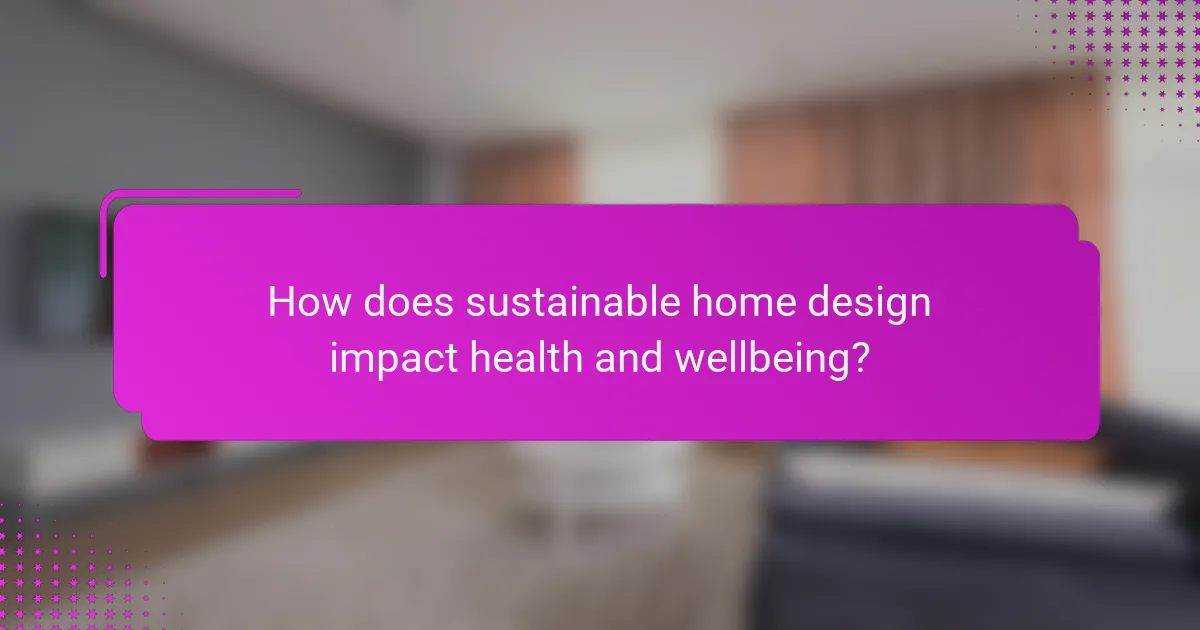
How does sustainable home design impact health and wellbeing?
Sustainable home design significantly enhances health and wellbeing by prioritizing natural materials, energy efficiency, and environmental harmony. These elements contribute to a healthier living environment, reducing exposure to harmful substances and promoting overall wellness.
Improved Indoor Air Quality
One of the primary benefits of sustainable home design is improved indoor air quality. By using non-toxic materials and ensuring proper ventilation, homes can minimize pollutants and allergens, creating a healthier atmosphere for occupants.
Consider incorporating features such as low-VOC (volatile organic compounds) paints, natural fiber carpets, and efficient air filtration systems. These choices can lead to a noticeable reduction in respiratory issues and allergies, enhancing comfort and wellbeing.
Regular maintenance, such as changing air filters and ensuring adequate ventilation, is crucial. Homeowners should aim for a balanced indoor environment, ideally maintaining humidity levels between 30-50% to prevent mold growth and promote optimal air quality.


